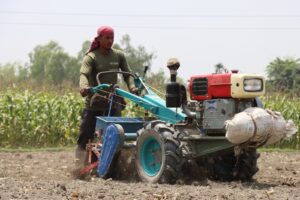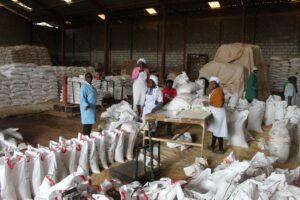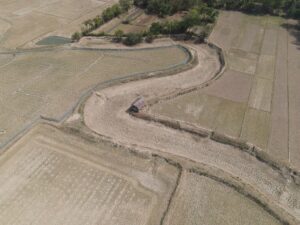The African Continental Free Trade Area agreement is going to be a major trade shock. Our results show that it has the potential to significantly change global sourcing structures and the formation of production networks within Africa. However, achieving the African Union’s continental trade goals will require strategic development of regional food processing and supply chains that capitalize on the existing production and local processing potential and access to markets.
International trade integration has deepened over the past decades, not only in the world but also in Sub-Saharan Africa. This trend is partly attributed to countries’ efforts to liberalize trade unilaterally and engage in free trade and regional integration agreements.
In March 2018, 44 heads of state from 44 African countries met in an Extraordinary Summit in Kigali, Rwanda, to sign the framework agreement forming a new African Continental Free Trade Area (AfCFTA), the largest free trade area in the world, covering over 1.2 billion people and generating USD 2.5 trillion in GDP.
To date, 54 of the 55 member states of the African Union have signed the agreement, which entered into force on 30 May 2019 for the 27 countries that had deposited their instruments of ratification. Trading under the AfCFTA commenced on 1 January 2021 after postponements due to the COVID-19 pandemic.
As of today, the African share of world exports only represents 2%, and trade between African countries barely exceeds 10% of the total trade of Africa, which is much lower than the intra-regional trade share of other continents. The structural causes of Africa’s ‘under-trading’ are profound: the small economic size of African economies, the vast distances that separate them, and the specialization in natural resources that they can buy from each other in only limited quantities.
Intra-continental agricultural exports have steadily grown over the past two decades. Intra-regional trade in Africa is attributable to regional factors such as geographic proximity, cultural similarities, historical trading relationships, and preferential trade agreements, while current policy and non-policy barriers to trade likely deter exchanges among African countries. However, trade occurs predominantly within regional economic communities without developing a strategic web of regional supply chains within the continent.
Moreover, intra-continental agricultural trade, although relatively less diversified in Africa compared to Europe, is significantly more diversified in Africa than in South Asia. Intra-continental trade expansion can leverage regional differences in the competitiveness of African countries in key food value chains.
Nonetheless, the current pace of trade growth within Africa remains slow, prompting a recent commitment by African heads of state to triple intra-continental agricultural trade by 2025 and raising questions about the feasibility for Africa of enhancing its food security through its regional supply chains and greater intra-African trade.
Among the steps taken to facilitate expanded African trade, countries launched the AfCFTA. The AfCFTA aims to create a single continental market for goods and services, harmonizing different trade liberalization processes currently occurring in the continent and boosting regional integration. There are about 30 bilateral or regional trade agreements within the continent, and each African country is a member of at least one of them.
Despite the marginalization of Africa in the world trade system, the African Regional Trade Agreements ushered in an era of economic integration with strong trade creation effects. Nonetheless, African countries continue to impose high duties on trade with each other—overall intra-continental import tariffs on both agricultural and non-agricultural goods average 8.6%, the highest intra-continental trade tariff in the world.
More specifically, on average, tariffs on agricultural goods reach 19.58% while tariffs on non-agricultural goods average 8.3%
As a consequence, the route towards free trade raises some serious challenges and issues that need to be addressed by African countries, especially for the agricultural sector, which remains a key sector to employment and overall economic development.
The present level of global and regional value chain engagement of most countries in Africa is rather low. Given the shift in international trade from goods to tasks, for the AfCFTA to have a transformative effect on member countries, it would need to spur the development of the nascent supply chain on the continent: to what extent may the AfCFTA contribute to global and regional production fragmentation and the formation of production networks?
Our results show that the answer to this question depends not only on the composition of trade volumes by product (primary goods vs. manufacturing goods) and the composition of trade volumes by destination (inter- vs. intra-regional trade) but also on the structure of trade in terms of the different value added components.
Accordingly, we compute value-added trade flows as well as model-based measures for production networks, and we find that the associated trade cost changes spur global production fragmentation so that the AfCFTA is likely to be a driving force behind the strengthening of production networks with its neighbours.
Our results show that the regional agreement is expected to not only increase the intra-regional trade flows but also to deepen the agricultural and food value chains at the regional level. We also show that the AfCFTA would contribute to strengthening trade linkages between African countries overall. In this respect, the AfCFTA would remove one of the obstacles impeding progress to greater participation in supply chain trade, namely high tariffs on intermediate inputs.
As a consequence, we register a rising share of trade in value added (relative to gross trade), which indicates growing participation in global value chains. At the same, this trade expansion and integration within Africa and the emergence of an African export ‘platform’ is expected to occur at the expense of trade with partners outside Africa, especially with Asia, mostly China. Interestingly, we also find that the trade flows between Africa and the EU would largely remain unaffected.
The AfCFTA will facilitate more participation of agricultural and food sectors in complex global value chains trade (defined as trade in intermediates crossing at least two borders) through an increase in forward as well as backward participation. Due to the AfCFTA, countries are going to be less reliant on the export of agricultural intermediates for the production of final goods with higher value added. However, we find that the reduction in trade costs within the region has a higher incidence on backward intra-regional integration than on forward participation, on average, but this pattern varies substantially across countries.
In addition, the AfCFTA would result in a net overall increase of food exports attributed in part to a rise in value added for food exports and also to an increase of the value of foreign and other sectors’ intermediate inputs. This means that most of the value added embedded in food exports would be sourced from other domestic sectors, further demonstrating the integration effect of the AfCFTA. In other words, we find that the continental agreement translates into more widely spread benefits across sectors if we consider the income generated within each sector (value added) rather than simply accounting for gross exports.
Moreover, foreign sourcing of intermediates rises more quickly than exporting as highlighted by the decline in the domestic value added (DVA) to gross exports ratio. This is good news because African exporters may access lower-cost suppliers of intermediate products. We find that the aggregate increase in DVA ratio was driven both by a higher domestic content share of processing exports and a relative shift towards ordinary exports, which contain significantly more DVA to begin with. These are sizeable effects if one takes into account that the only difference between the baseline and the counterfactual is the tariff structure since we do not include numerous non-tariff measures on top of tariff cuts.
However, the pattern is by no means universal in terms of either countries or sectors. The size of the potential changes in the structure of trade depends critically on the initial level of trade barriers and the strength of initial intra-African trade ties.
Given the importance of the EU–Africa economic relationship, it is worth noting that the current EU common agricultural policy hampers the development of African agriculture much less than it did before with export subsidies and coupled subsidy payments. Although African raw agricultural material exports to the EU are largely free of duties under various agreements, processed products are only free of duties if they can be ruled out under the ‘country of origin’ principle that components of the final good were imported from a third country.
The proof of origin requires a list of the production stages and ingredients, as well as their origin. This condition often makes it difficult for African exporters to export processed agricultural products to the EU, hindering the creation of regional value chains. A simplification of and more flexibility on the rules on origin (supported through consultation with trading partners) should be sought provided the majority of the ingredients originate in the partner country or regional economic areas, such as the AfCFTA.
In this respect, it is worth recalling that the AfCFTA annex on Rules of Origin (RoO) has not yet been finalized. RoOs that are too restrictive can negate the preferential market access intended by the FTA and prevent regional supply chains from functioning independently from the EU choices.
The AfCFTA is going to be a major trade shock. Our results show that it has the potential to significantly change global sourcing structures and the formation of production networks within Africa. However, achieving the African Union’s continental trade goals will require strategic development of regional food processing and supply chains that capitalize on the existing production and local processing potential and access to markets.
Indeed, for the AfCFTA to realize its economic and trade transformation potential, member countries are likely to need to adopt a mix of policies and investments to spur the development of the nascent supply chain on the continent. Yet policymakers must proceed cautiously—trade policy changes can have unintended consequences for informal, local supply chains and dietary habits, sometimes excluding producers or elevating less-nutritious processed foods over traditional dietary staples.
Moreover, realizing the ambitious AfCFTA agenda requires dealing with the political economy of execution. The success of the AfCFTA may require complementing trade policies with national policies that make the gains from trade more inclusive—for instance, policies that may range from re-training workers for new tasks/jobs as a result of technological changes, to adequate regulatory frameworks to promote investment and competition, to social protection of the most vulnerable.
We have also shown that the AfCFTA would displace trade flow to some extent. These effects are not likely to be neutral from a geopolitical perspective and the implications on international relations would need to be watched. This study contributes by bringing quantitative elements that will further document the debate on the necessary framework, reforms, and investments for a pooled African market.
Read the study:
Fusacchia I, Balié J, Salvatici L. (2022) The AfCFTA impact on agricultural and food trade: a value added perspective. European Review of Agricultural Economics, Volume 49, Issue 1, Pages 237–284,






